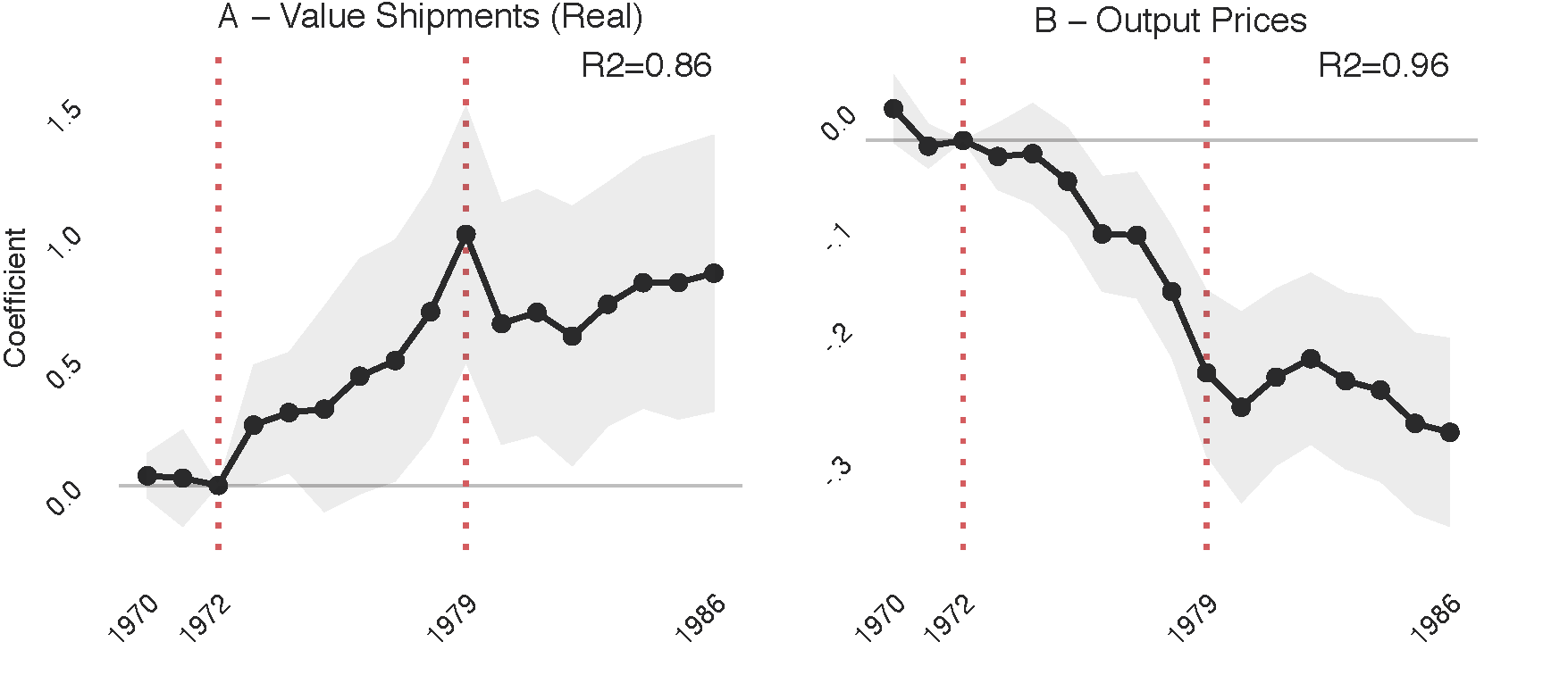
South Korea’s industrial policy in the late 1970s played a critical role in forging its modern economy. Are there lessons for the developing world?
Industrialising is perceived as the engine to economic growth. Hence, most developing economies aspire to industrialise. To this end, industrial policy is a common tool used to shape the composition of national economic activity. Industrial policies are as controversial as they are ubiquitous, and few contemporary empirical studies have explored their impact. There is no consensus on the efficacy of these interventions; evidence is anecdotal, mixed, and piecemeal (Harrison and Rodriguez-Clare 2009). Industrial policies across Latin America and Africa are seen as lackluster, often undermined by rent-seeking and predation (Evans 1995). Meanwhile, many have argued these interventions were essential to the East Asian growth miracle (Wade 1990, Amsden 1992). Others have debated this fact (Noland and Pack 2003).
A big question remains – can industrial policy promote industrial transformation in developing countries? If so, how? In a recent study, I tackle these issues by studying the impact of South Korea’s seminal, industrial push – the Heavy Chemical and Industry (HCI) drive of 1973-1979. My study explores how the large, temporary infant industry policy impacted the trajectory of treated industries, as well as sectors connected to them through the industrial network.
Context of South Korea’s big push
Using archival data and newly digitised sources, I compare the evolution of industries targeted by South Korea’s industrial policy, relative to those that were not targeted. The six-year HCI push consisted largely of two levers: trade policy, in the form of imported input subsidies; and heavily discounted credit. The programme's goal was to rapidly promote a move into capital-intensive strategic industry, such as steel, nonferrous metals, and petrochemical processing.
External politics shaped the introduction and withdrawal of the policy. President Nixon's troop pull-out from Asia in the early 1970s precipitated an Asian political crisis. The withdrawal shook South Korea, which for decades had depended on Western military aid to deter North Korean invasion. The 1970s political crisis on the Korean peninsula inspired President Park Chung Hee to declare a dictatorship, the cornerstone of which was the HCI policy. This intervention was a sudden tact in the country’s policy regime – from general export promotion to targeting ‘strategic sectors,’ that, among other things, could be used in domestic military production. President Park’s assassination in 1979 guaranteed the sunset of the landmark industrial drive.
Using multiple measures of industrial development – such as output growth, employment, output prices, and industry share of output – I study the impact of HCI policies, comparing targeted industries to non-targeted manufacturing industries before and after 1973. Differences between industries before the policy represent a counterfactual sectoral structure; absent the big push interventions, manufacturing industries would have evolved according to Korea's static comparative advantage. Estimated differences after 1973 represents the differential impact of the policy.
The development of treated sectors
What were the big push policies? Before turning to the main results, I show that the HCI relied heavily on capital subsidies and exemptions from import tariffs, rather than explicitly protecting output markets. My estimates show that this policy packed a punch – on average, treated industries accumulated nearly twice the value of capital than other manufacturing industries. Contrary to popular wisdom, I find no significant difference in the output tariffs across treated and non-treated industries.
Big push policies spurred rapid industrial development in treated industries. Figure 1 plots the estimated differences between targeted and non-targeted sectors, relative to 1972 levels, for (real) gross output and average output prices. Concerning output, my study shows that targeted industries grew an average of 80% more than non-targeted manufacturing industries, after 1973.

Importantly, unlike other industrial interventions in developing countries, treated industries experienced a rise in labour productivity and, crucially, declining output prices. After the policy introduction, output prices of targeted sector products were 11% lower than non-targeted manufacturing goods.
Linkages effects: Downstream winners, upstream losers
Since Albert Hirschman (1958), a key argument for industrial policy interventions is that they can create positive spillovers through supply chain connections. For example, support provided to the right industries may potentially benefit their suppliers or purchasers (Liu 2017).
To explore the network externalities of the HCI drive, I compare the evolution of non-targeted industries with weak linkages and those with strong linkages to targeted sectors. I do so by creating forward and backward linkage measures from digitised input-output accounts. Industries with strong forward (downstream) linkages purchase a large share of their inputs from targeted industries; industries with high backward (upstream) linkages, sell a large share of output to targeted industries.
The HCI policy positively impacted forward-linked industries, but negatively impacted backward-linked industries. My results suggest, surprisingly, that industrial policy lowered the prices for downstream buyers, unlike many historical industrial policies (Schmitz 2001). Estimates indicate that a 1% increase in the cost share of intermediate inputs from treated industries corresponds to a 1.2% rise in gross output.
However, the big push had more nuanced effects than anticipated by classic developmental economists. HCI trade policies allowed targeted industries to significantly increase intermediate imports, subjecting domestic suppliers to import competition. For upstream sectors, I estimate that a 1% increase in the share of output directly sold to targeted industries decreased industry output by about 0.7%. Thus, the HCI policy tended to benefit downstream industries, while negatively impacting upstream suppliers.
What we’ve learned and what we haven’t yet
What do we learn from South Korea’s ambitious industrial policy experience?
- The HCI policy, while largely temporary, nonetheless created lasting effects in targeted industries relative to other manufacturing industries.
- The extraordinary growth of heavy industries was helped by capital deepening and expansion of imported input goods.
- Growth in targeted industries also corresponds to growth in advanced, downstream buyers. Unlike many industrial policies, the lower prices in targeted industries likely benefited purchasing industries.
- Allowing targeted industries to import advanced inputs from abroad was likely crucial. However, this meant that some domestic suppliers were subjected to trade competition, and shrunk.
However, lessons from the HCI experience must be qualified. First, this study says very little about the tremendous costs of the programme – in particular, the macroeconomic costs associated with it. Second, I have yet to take a stance on the aggregate welfare implications of the policy. Third, how the impacts of the HCI policy translates to aggregate growth is yet to be seen. Finally, my study does not speak to the intricate political economy issues that allowed South Korea (and others) to execute ambitious industrial strategies in the first place (Evans 1995). It is unlikely that many low-income countries have the administrative capacity to implement orchestrated, surgical industrial policies. Nonetheless, history tells us that intentional industrial policies likely played a critical role in creating the modern South Korean economy.
References
Amsden, A (1992), Asia’s Next Giant: South Korea and Late Industrialization, Second edition, New York, New York: Oxford University Press.
Evans, P B (1995), Embedded Autonomy: States and Industrial Transformation, Princeton, New Jersey: Princeton University Press.
Harrison, A E and A Rodriguez-Clare (2009), “Trade, foreign investment, and industrial policy for developing countries", in Handbook of Development Economics, D Rodrik & M Rosenzweig (eds), Volume 5: 4039–4214, Amsterdam: Elsevier BV and North-Holland.
Hirschman, A O (1958), The Strategy of Economic Development, Third edition, New Haven, Connecticut: Yale University Press.
Lane, N (2017), “Manufacturing revolutions: Industrial policy and networks in South Korea”, Working Paper.
Liu, E (2017), “Industrial policies in production networks”, Working Paper.
Noland, M and H Pack (2003), Industrial Policy in an Era of Globalization: Lessons from Asia, Washington, DC: Institute for International Economics.
Schmitz Jr, J A (2001), “Government production of investment goods and aggregate labor productivity”, Journal of Monetary Economics 47(1): 163–187.
Wade, R H (1990), Governing the Market: Economic Theory and the Role of Government in East Asian Industrialization, Second edition, Princeton, New Jersey: Princeton University Press.

